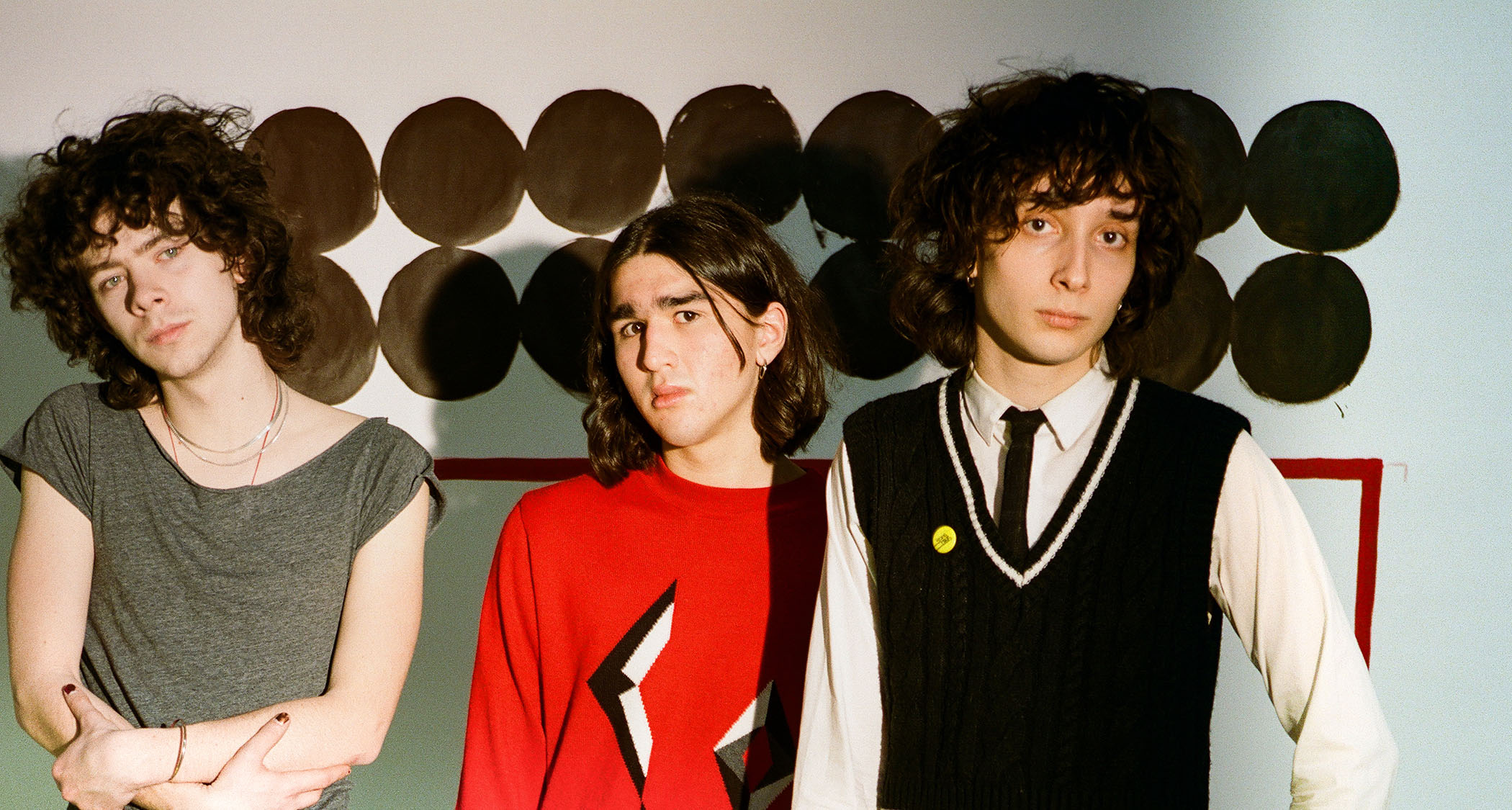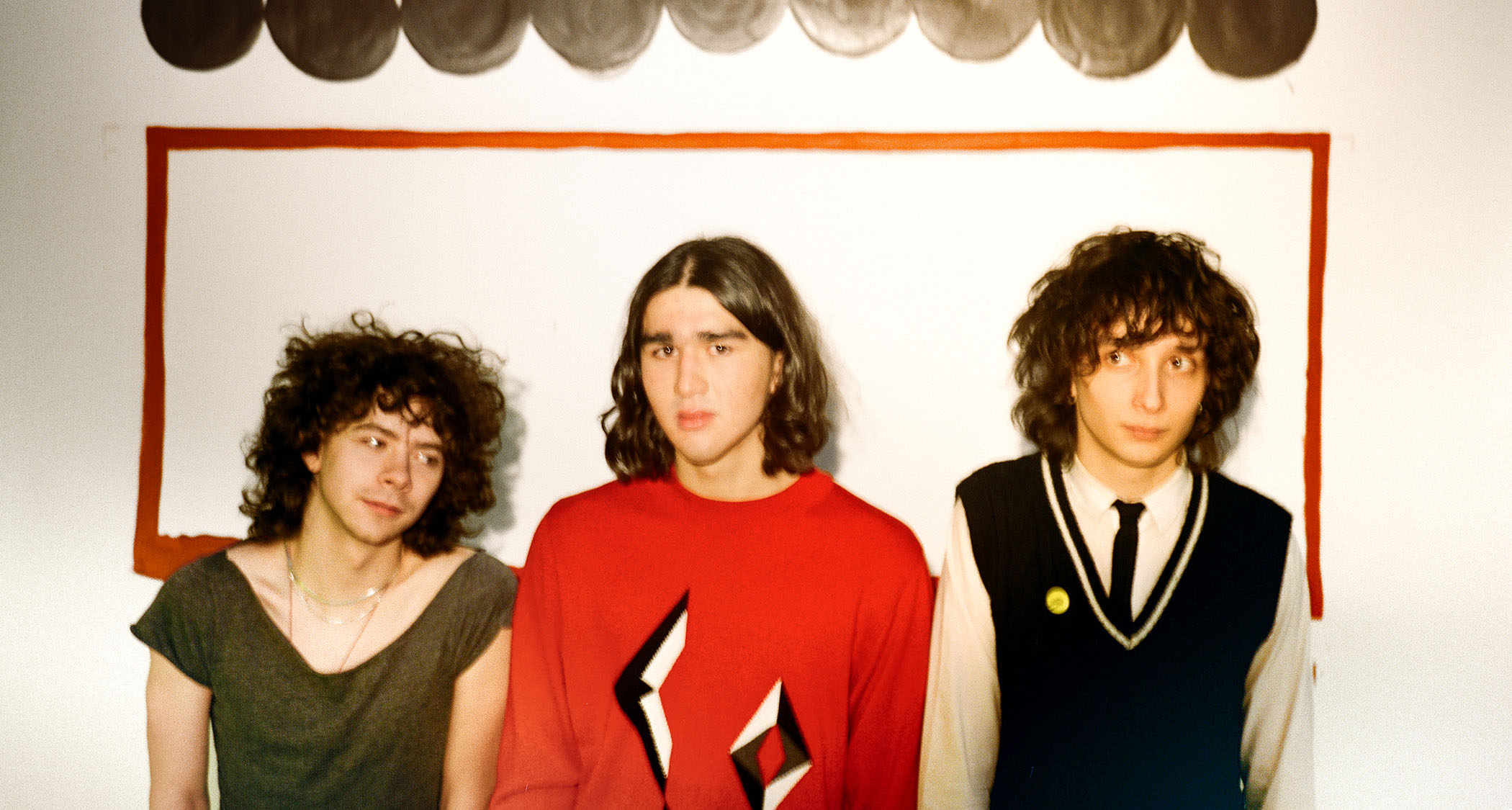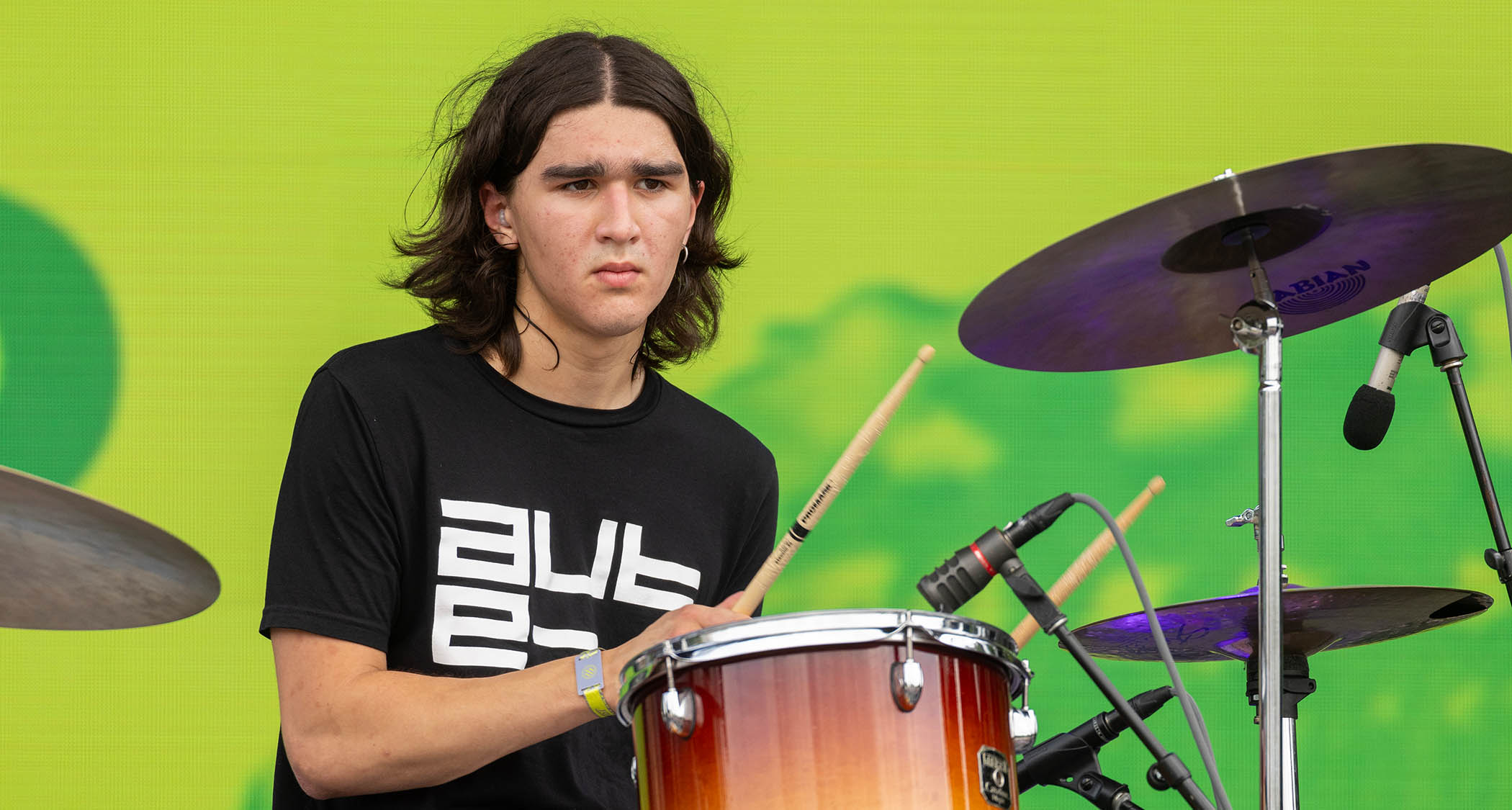“If you were to look at his amp settings onstage, you’d be like, ‘Why is he doing that!? Turn that down”: Lifeguard on adventures in improvised sound, creative epiphanies, and how they found the balance between abstract noise and pop hooks
The Chicago trio's debut LP, Ripped And Torn, is a half-hour riot of post-punk urgency, freewheeling experimentalism and the sound of a band figuring out how to give their audience whiplash

Ripped And Torn, the debut album from Chicago trio Lifeguard, is the exhilarating sound of youth in revolt and in service to a very precise intention to take what might have been long-form improvisational noise – and all the electric guitar klang and skronk that goes with that – and turn it into a concise work of stylistically radical rock.
“We liked this idea that you had this rock record that you accidentally dubbed onto like a noise tape or something,” says vocalist/guitarist Kai Slater. “And so it feels like sometimes you get these snippets of something completely different. But I think it’s very true to the band as this improvisational unit.”
Lifeguard was formed in 2019, initially as a duo featuring Isaac Lowenstein on drums and Asher Case on bass guitar. The pair met at one of those ‘School of Rock’-style camps when they were kids (a fact that was relayed to us by Laurent Schroeder-Lebec of fellow Chicagoans Pelican, who counts himself a fan). Slater joined soon after.
All three are not long out of high-school and yet Ripped And Torn exhibits a prodigious musical vocabulary. Produced by Randy Randall (No Age), it is animated by the creative energies of three restless imaginations pulling on different strands of musical curiosity and weaving them together. No-wave, dub, post-punk, post-hardcore, lo-fi indie, art, noise and avant-rock… You can hear all of that. You can use all these descriptors and more.
After a slew of EPs, ensconcing themselves in Chicago’s DIY scene (Lowenstein’s older sister, Penelope, plays in Matador labelmates Horsegirl), playing live shows wherever and whenever they could, Lifeguard have got their sound down to the point where they can pull out an obscure – maybe even hostile – sound out and ambush the audience with it. Case says those jarring juxtapositions are tricks they’ve picked up from bands such as This Heat. Lifeguard want to give you whiplash.
“The thing that really grabs your attention is when that splice hits, and it’s that immediate catharsis – or whiplash – from hearing this new abrasive thing, in the same way that you would have whiplash from a really fucking good hook,” he says. “It’s like an immediate thing.”
The immediacy is key. Even if they might be drawing from high-concept art-rock, presenting improvised guitar over own of Lowenstein’s synthesizer drones, they still want this to be danceable.
Want all the hottest music and gear news, reviews, deals, features and more, direct to your inbox? Sign up here.
Even if they have an appetite for atonality, they know when to go pop and give us a hook. Take a track like It Will Get Worse, which presents us with a glorious shambles of punk-rock guitar scratch, eighth-note stabs over dreamy vocals, and melodies that are hard to shift.
Lifeguard’s sound is all contrasts: between the metallic treble of Slater’s guitar and the warm, fuzzy thunk of Case’s bass; between the propulsive backbeat of Lowenstein’s drums – hit flat and hard – and the anti-tempo noise tracks like Music For 3 Drums and Charlie’s Vox. It’s a free-for-all and yet it’s not. Because, as they explain here, there’s an intentionality. All of these sounds are here by design.
How did you work out where to place the noise elements in and alongside the songs?
We got better at figuring out how to make songs. A lot of the time, when you start, you’re like, ‘Let’s do this piece and then let’s go to another part, and then and then smash it together and then that’s a song’
Kai Slater
Isaac Lowenstein: “We are playing with intention a lot. Those recordings, those noisy bits came from these much longer jams. I think some of them ended up lasting half-an-hour. A lot of it was figuring out what the best parts were and trying to chop it down to a tenth of the size.”
Asher Case: “These things were made with the songs and they are very inseparable – in my mind, in our minds – but then you don’t want to make your record three hours long, with the entirety of these [jams] on there because it’s going to be boring. It’s not going to work or it’s going to come across in a way that you don’t want.
“You basically give it as much time to communicate the idea as you can, and then it’s over, and you can move on. You can put it next to another one of those things, or you just put it next to a song or something.”
On this record, was the biggest effort to be so disciplined and concise with your songwriting?
Lowenstein: “Well, the process of making it oftentimes is really drawn out, but in our very beginning, it was the closest we’ve ever gotten to sort of releasing our jams. We did these EPs and kind of a record – although this is really the debut – and a lot of that stuff meanders too far towards jams without much intention.
“I think that we found that keeping this concise was more our identity than just letting these jams kind of linger. Actually, finding out that we are definitely not a jam band is as an important part of figuring out what Lifeguard was.”
Slater: “We are just really into songs, and we got better at figuring out how to make songs. A lot of the time, when you start, you’re like, ‘Let’s do this piece and then let’s go to another part, and then and then smash it together and then that’s a song.’
“But the art of making a song come across cohesively and in a short amount of time is something we are more interested in.”
Case: “Yeah, we all have an aversion to the look of a song that is like, ‘Oh, this is very clearly two parts they like spent 45 minutes jamming and then just put them together.’ I feel like it’s just us getting away from ourselves more so than getting away from... like being associated with being a jam band.”

Lowenstein: “Sometimes there can be this idea that improvisation deserves this kind of long, sort of brooding [experience] – like it hits you slowly – but what we had discovered is that improvised music does not need to be so drawn out.
“I don’t know what what word I’m looking for but there is sometimes this perspective of it being like high art, where you need to have your arms crossed and be nodding your head.
“A big intention behind this whole thing was to try taking that really weird stuff and trying to flip it into something that feels really immediate, that feels like in some sort of weird sense you can still dance to it – and keep it short rather than it being some kind of chin-stroking music.”
You have all these uncanny juxtapositions in the sounds. Kai, your guitar has so much treble. But then the bass is like a mile away, creating all this depth in the mix.
My favourite guitar tones are like Johnny Thunders, or Guided By Voices or Big Star, like really trebly pop records like that, jangly stuff
Kai Slater
Slater: “Definitely I would say me and Asher have been learning what we like our instruments to sound like, and we come from distinct influences. My favourite guitar tones are like Johnny Thunders, or Guided By Voices or Big Star, like really trebly pop records like that, jangly stuff, but then there’s a dub influence.
“I don’t want to speak on Asher’s behalf, but when you’re talking about that stuff those are very two different worlds but it is hard not to bring our own influences into that.”
Case: “Yeah, I listen to a lot of dub records, but also a lot of no-wave records where the bass is really present and stubby and under things, and I really like how that plays with sparkly guitars, and thin sounding guitars, and that’s something we can replicate when we are together.
“Also, when I am thinking about how my bass sounds in reference to Kai’s guitar, it is mostly in terms of ‘Can I hear it the right way? Is it loud enough? Is it spaced out or muddy?’ As a trio, we are always concerned with hitting the balance that is easy to hit as a trio, where you can just hear everything in the rehearsal room easily and all the information can be communicated.”

Lowenstein: “I definitely feel like the tones came out of necessity. Live, if you were to look at Kai’s amp settings onstage, you’d be like, ‘Why is he doing that!? Turn that down. Bring that treble down.’ But I think getting that very exact separation where it’s like pure highs and pure lows and then the drums sit somewhere in the middle, weirdly, we have been able to achieve this real fullness, and separation between the three of us.”
Slater: “I also have been interested in not leaning so hard into distortion and having a thick fuzz tone. Most of the guitar tones on the record, there was no distortion pedal. It was the amp, like breaking up the amp. It’s just loud.
“Yeah, it was out of necessity, but stylistically we did the Jam cover [In The City], and with guitar tones like that, you are not actually using that much distortion. I am leaning away from a shoegaze sensibility and tapping into the pure band dynamic and what everyone is adding.”
Some of these tracks have this surreal disembodied quality. Like You’ll Lose has this bass that’s almost like a Silver Apples synth part the way it sounds and is phrased. What amps and guitars did you use on the record?
Slater: “For this record I used a Fender Blues Junior, like a really, really small amp and then I think I was playing a Strat through that, and I had mids and treble all the way up, and a little bit of bass just so the bass would break it up. Not even to have it be bassy – like, obviously it’s not – but just to make it struggle and die and wheeze, and stuff like that.”
Case: “I play an Ovation Magnum bass and I go through an Acoustic [Control Corp] amp, a 220 head and 2x15 cabinet. It is my favourite amp because it is as tall as my body, so I can stand in front of it and feel the instrument in my body, which is much easier for me to hear it when we are playing. And on this record we wrote some songs on a baritone guitar, so I am playing a baritone on a couple, like the one that came out two days ago [It Will Get Worse].
“And that was a really interesting thing because I am playing it out of a bass amp with the same settings, but that guitar is so much more electric, like more magnetic sounding, and weirdly resonant, and tuned in a way that it is mostly standard, but then there are two strings that are the same tone, so getting them just to be a little off gives it a little bit more of a surreal quality. Like what you were saying, it doesn’t sound completely right but it still fits in the same place as the bass does in this weird way.”
And you don't use pedals either?
Case: “Relying on pedals, if that goes wrong then your show is ruined and it’s pretty embarrassing.”
You can make a bass plummy and warm, or raw and low like a synth, but baritone is harder to disguise. It has this guitaristic quality, twang whether you want it or not.
Case: “Definitely. It just makes me think of those two things as two very different instruments, and the way that the bass is sort of settled in comparison to the baritone, it’s a place that’s way more subdued, but deep and loud. And the synth comparison is very cool. I like that a lot. I had never thought about it, honestly.”

What about yourself, Isaac? What are you playing on?
Lowenstein: “What like the drums?”
Slater: “Talk about the keys!”
Lowenstein: “[Laughs] Yeah, yeah. I got it. I believe the kit was one of those house kits that we recorded with at Palisades. And that was a ‘60s Ludwig kit that we taped and muted. My snare is a Ludwig Acrolite from ’74. Yeah, what were you going to tell me to talk about, Kai?”
Slater: “Your keys!”
Lowenstein: “My keys? Oh, oh, yeah.”
Case: “And the Crumar and stuff.”
Slater: “And the Crumar!”
Lowenstein: “So, additionally, on the record, my other kind of role was doing keyboards and synthesizer, noise stuff. Most of the droning noise stuff – like there’s usually guitar over it, doing more staccato stuff and the droning held notes are me on an Arturia MicroFreak running through a Hoof Reaper from EarthQuaker [Devices]. It’s like a double distortion and an octave, but the octave doesn’t do anything for me. So that’s what I have next to me during the live show and that’s what I have for the drone in Under Your Reach.
“Also, when we recorded the record, we used a vintage Italian organ called the Crumar. The organ tones all through the record were done on that. The lowest two octaves on the Crumar are this awesome Moog-y analogue bass circuit, so on like Ripped And Torn, the title track, we have a bassline matching Asher so there’s like this one clashing note. We are also obviously playing around with a lot of echo stuff, Roland tape echo, rack effects to throw the drums through.”
Slater: “And we tracked the record on an Atari 16-track reel-to-reel.”
Echoes and drones are like the fourth member of the band. It’s almost like a war on silence when there’s some noise underneath all the time.
Lowenstein: “The drums at the beginning on Under Your Reach, we conceptualised that as a transmission from this crazy improvised thing we do during the live set, so start that, so there is never a break of silence between the improvised thing and the start of Under Your Reach. But the idea of always keeping the energy, or keeping it sustained throughout the set, throughout the record, has been essential.
“The echoes, we played a lot with space and the absence of stuff, too, and there are several times through the record where there are little moments of silence that are really meant to draw your attention. But in every other moment, the point is to always have consistent music right down the centre.”
Slater: “For me, the only silences are before the last track and there’s one noise piece where the tape got eaten, so it just kind of drops out and sputters back in, those are the only two I can think of.”

It all goes back to what you said at the start, Isaac, about intention, and how you want the tunes to land – and how hostile it should sound, how friendly.
Lowenstein: “It was really important to us to keep the most palatable pop tracks in there – and even with the production, too, it’s never supposed to get hurting. All of the drum sounds are tame and are never ringing. Everything is muted and staccato, and ‘in the vacuum.’
“It definitely took a while to figure this out, deciding how challenging or unfriendly the record should be, right? I think we knew we wanted a pop record, but it took a while to figure out why such noisy stuff – for a long period of time – wasn’t working.”
- Ripped And Torn is out now via Matador.
- Lifeguard are on tour in Europe and the UK. See Lifeguard for dates and tickets.
Jonathan Horsley has been writing about guitars and guitar culture since 2005, playing them since 1990, and regularly contributes to MusicRadar, Total Guitar and Guitar World. He uses Jazz III nylon picks, 10s during the week, 9s at the weekend, and shamefully still struggles with rhythm figure one of Van Halen’s Panama.
You must confirm your public display name before commenting
Please logout and then login again, you will then be prompted to enter your display name.







